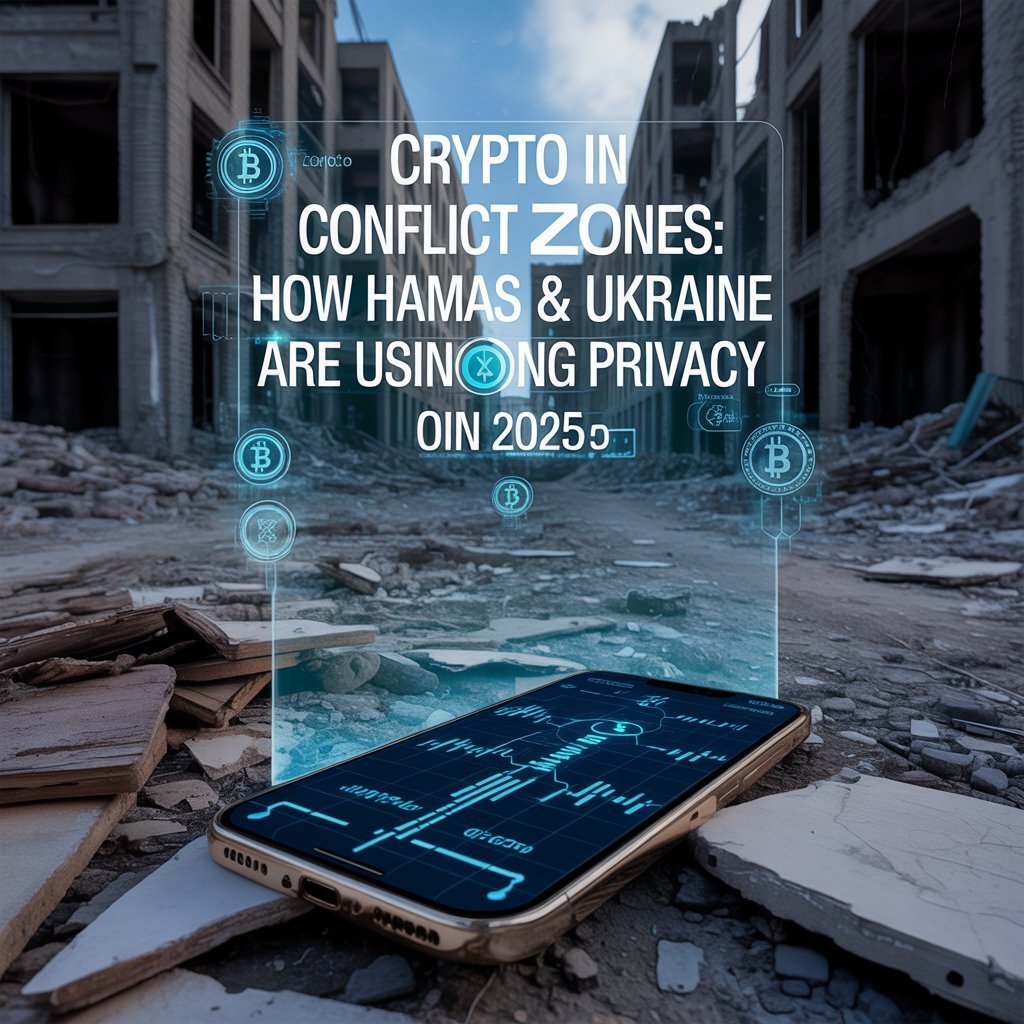In 2025, the use of cryptocurrencies in conflict zones has moved beyond simple speculation or novelty. It’s now a real-world, high-stakes tool used for survival, strategy, and sovereignty. This shift has placed privacy coins like Monero (XMR), Zcash (ZEC), and even emerging alternatives such as Oxen and Firo at the center of a global ethical and political debate.
From the war-torn streets of Gaza to the embattled borders of Eastern Ukraine, both Hamas and Ukrainian forces are reportedly turning to crypto not just Bitcoin or Ethereum but privacy coins that cloak transactions in anonymity. These tools offer fast, borderless, censorship-resistant financial systems… but their implications are anything but simple.
This blog explores how privacy coins are being utilized in these zones, what makes them attractive in times of war, and how the global community is responding.
1. The Rise of Privacy Coins: Why They Matter in War
Bitcoin may be the face of cryptocurrency, but it’s not truly anonymous It’s pseudonymous. Every transaction is traceable on the blockchain. For actors in a conflict zone, governments, rebels, NGOs, or smugglers, this is often too risky.
Enter privacy coins. These cryptocurrencies are designed to obscure the origin, amount, and destination of transactions. Here are a few leaders in this category:
- Monero (XMR): Uses ring signatures and stealth addresses to obscure identity and transaction amounts.
- Zcash (ZEC): Offers both transparent and shielded transactions using zk-SNARKs.
- Oxen (OXEN): Offers anonymous messaging and private transactions.
- Firo (FIRO): Uses Lelantus and Sigma protocols for full privacy.
These assets are ideal for groups operating under surveillance, embargo, or legal gray areas. But how exactly are Hamas and Ukraine employing these tools in 2025?
2. Hamas and Privacy Coins: Sanctions, Secrecy, and Strategy
Hamas, the governing authority in Gaza and labeled a terrorist organization by many Western nations, has long faced restrictions on traditional banking systems. After repeated crackdowns on conventional crypto fundraising efforts (such as via Bitcoin), Hamas is allegedly turning to privacy coins like Monero to fund operations.
Why Privacy Coins?
- Evading Detection: Monero transactions are near impossible to trace with current blockchain analytics tools.
- Circumventing Sanctions: International banking is closed off; crypto is a backdoor.
- Donor Anonymity: Individuals and organizations can contribute without fear of political or legal backlash.
Documented Use Cases (as of 2024-2025)
- Private Donations: Fundraising via encrypted Telegram channels now includes Monero wallet addresses.
- Military Procurement: Intermediaries allegedly use privacy coins to purchase hardware and convert to stable assets off-chain.
- Offshore Conversions: Partnered OTC (over-the-counter) crypto traders exchange XMR for usable fiat or Tether (USDT) in Lebanon, Turkey, or Iran.
This method is far from foolproof but represents a significant escalation in sophistication.
3. Ukraine and Privacy Coins: A Double-Edged Defense Tool
Ukraine’s use of cryptocurrency has been widely praised during the Russian invasion, especially its early 2022 government-led BTC and ETH donation campaigns. However, by 2025, privacy coins are quietly gaining traction in their war economy, for both strategic and defensive purposes.
Strategic Use Cases
- Covert Aid Distribution: Privacy coins are used by Ukrainian intelligence and NGOs to support field agents, families behind enemy lines, and local resistance in occupied territories.
- Asset Protection: Wealthy Ukrainians and displaced citizens use privacy coins to protect funds from confiscation or surveillance by foreign powers.
- Secure Procurement: Purchases of arms, drone components, and encrypted communication tools are facilitated using privacy assets to avoid Russian tracking.
Ukraine’s Transparency vs. Secrecy Dilemma
Ukraine’s official stance is one of transparency and Western compliance. However, unofficial channels suggest growing reliance on untraceable crypto to stay ahead of a technologically sophisticated Russian surveillance machine.
It’s a balancing act between leveraging global support and securing national interests without jeopardizing aid or triggering sanctions.
4. Regulatory Blowback: The Global War on Anonymity
The increased use of privacy coins in conflict zones has put them in the crosshairs of international regulators.
2025 Developments:
- U.S. Treasury Sanctions: Several Monero-related wallet addresses linked to Hamas were blacklisted in early 2025.
- EU Privacy Coin Ban: The EU has enforced stricter KYC/AML laws, essentially outlawing exchanges that support privacy coins.
- Chainalysis Expansion: Major crypto forensic firms are investing heavily in AI to “de-anonymize” Monero and Zcash through metadata analysis.
Still, the underlying technology continues to evolve, with newer versions of zk-SNARKs and ring signatures staying ahead of detection efforts.
5. Ethical Gray Zone: Resistance or Terrorism?
The use of crypto in conflict zones begs a bigger question: is this financial liberation or digital warfare?
- Hamas’s use of privacy coins is seen by critics as digital terrorism funding.
- Ukraine’s use is framed as justifiable defense and humanitarian aid.
But what separates the two in practice may boil down to who’s telling the story.
Crypto doesn’t carry a moral compass it’s a tool. How it’s used depends on context, perception, and politics.
6. The Role of Decentralization in Future Wars
We are witnessing the weaponization of decentralized finance (DeFi). In 2025:
- DAOs (Decentralized Autonomous Organizations) are emerging to fund paramilitary resistance groups.
- Smart contracts are used to automate supply chains in real-time war logistics.
- Decentralized messaging platforms like Session (built on Oxen) are replacing Signal and WhatsApp in high-risk areas.
This trend won’t slow down. In fact, it’s likely to intensify as both authoritarian and democratic actors embrace the unstoppable nature of decentralized networks.
7. The Future of Privacy Coins: Crackdown or Evolution?
With privacy coins playing a rising role in global conflict, their future is uncertain.
What Lies Ahead?
- Shadow Markets Will Thrive: Expect darknet markets and unregulated exchanges to grow where governments fail to regulate.
- Governments May Fork or Clone Tech: Nation-states may start developing their own “approved” privacy coins.
- User Behavior Will Shift: More individuals may adopt hybrid privacy tools using mixers, wrapped tokens, or atomic swaps to stay under the radar.
If privacy is outlawed, only outlaws will have privacy an old saying that may soon define the next cyber battleground.
Final Thoughts: The War of Wallets
In 2025, privacy coins are no longer niche. They are tools of geopolitical significance. Whether in the hands of rebels or governments, they are altering the rules of engagement not just on the battlefield but on the financial frontlines.
The global community now faces a critical choice: Do we build better systems to ensure responsible use of these tools? Or do we push them further underground, empowering the very forces we seek to limit?
Either way, crypto is no longer just money it’s strategy, survival, and sovereignty.





